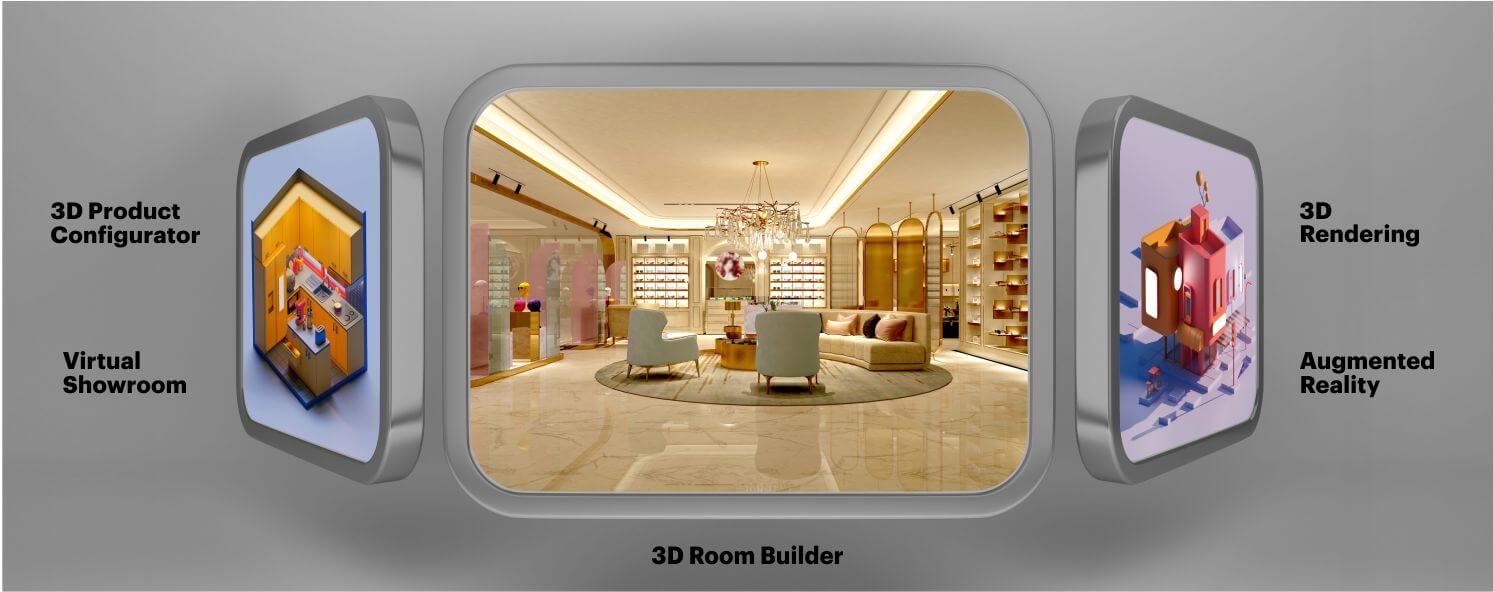Synopsis:
Explore the transformative impact of integrating 3D tools, such as 3D Room Builder and 3D Virtual Showrooms, in enhancing the home decor and furniture shopping experience. By immersing customers in interactive digital environments, businesses can provide personalised and immersive shopping experiences that bridge the gap between virtual and physical retail.
The blog will take you through the benefits of integrating 3D rendering, virtual showrooms, and product configurators, emphasizing their ability to boost sales, drive customer engagement, and foster loyalty.
Additionally, it underscores the importance of customisation and personalisation in today's competitive market and offers insights into leveraging these innovative technologies to create unique and memorable experiences.

Introduction
Business thrives on sales, and they constantly need innovative ways to improve the shopping experience for customers. Various such groundbreaking technologies are 3D room builder and 3D virtual showroom, collectively known as 3D tools.
These tools like 3D Room Builder, 3D Digital Showroom, 3D Product Configurator, and visual commerce offer unparalleled opportunities for businesses to display their products in a dynamic and immersive way.
This blog will study how integrating 3D tools can boost your home decor and furniture eCommerce sales.
What are 3D Tools?
Before diving into the different 3D tools, first, let’s understand what 3D tools entail. 3D tools encompass a range of technologies that create, visualise, and interact with objects in the real world.
Major applications like the 3D Room Builder and 3D Virtual Showroom improve the eCommerce experience by letting customers view and customise products within a simulated space.
A 3D Room Builder allows users to design and furnish virtual rooms. It permits them to see how furniture and home decor will look in their home before making a purchase. Meanwhile, a 3D Virtual Showroom offers an immersive walkthrough, where customers can explore a fully interactive digital environment.
Besides, a 3D Virtual Showroom offers an immersive walkthrough experience, where customers can explore a fully interactive digital environment. Similarly, a Virtual Product Showroom extends these capabilities, focusing specifically on individual product interaction and customisation, offering a hands-on feel.
These 3D tools are changing eCommerce, making shopping more interactive, personalised, and satisfactory by merging visualisation with user control.
How 3D Rendering Boosts Sales


3D Rendering or 3D Product Rendering boosts sales by offering unparalleled visual fidelity and customisation options to customers. With tools like the 3D Room Builder, businesses can highlight their products in lifelike environments and allow customers to envision how items will fit into their own spaces.
Moreover, including 3D rendering in a Virtual Product Showroom allows customers to interact with products from various angles, fostering a deeper connection and increasing purchase confidence.
By offering highly detailed and customisable representations, 3D rendering elevates the online shopping experience, reducing uncertainties and buyer hesitation. Furthermore, the integration of 3D rendering within a 3D Virtual Showroom allows customers to explore curated collections in a visually engaging and immersive manner.
By leveraging 3D rendering businesses can drive sales by offering customers an interactive and personalised shopping experience that closely mirrors the in-store experience. 3D rendering further allows customisation options, letting customers personalise their chosen products according to their preferences.
Whether it’s selecting different fabric options for a sofa or adjusting the dimensions of a coffee table, these customisation features cater to individual tastes, thereby driving customer satisfaction and loyalty.
How Virtual Showrooms Transform Shopping Experience
Virtual Showrooms revolutionise the shopping experience by immersing customers in interactive digital environments where they can explore products in a realistic and personalised manner.
Through tools like the 3D Room Builder, customers can design and visualise their living spaces, experimenting with different layouts and furniture arrangements. Within a 3D Virtual Showroom, customers can navigate through virtual environments, interacting with products as if they were in a physical store.
This immersive experience allows customers to gain a deeper understanding of product features and aesthetics, leading to more informed purchase decisions. Moreover, by integrating a Virtual Product Showroom, businesses can offer customers hands-on interaction with individual products, enhancing engagement and satisfaction.
Overall, virtual showrooms bridge the gap between virtual and physical retail, providing customers with a dynamic and engaging platform to explore and purchase products.
How Can You Leverage 3D Form Builder
Using a 3D Room Builder empowers businesses to offer customers a highly personalised and immersive shopping experience. By integrating this tool into your eCommerce platform, you can enable customers to design and visualise their ideal living space, complete with furniture and decor selections.
With the 3D Room Builder, customers can experiment with different layouts, colours, and furniture arrangements, allowing them to craft their virtual rooms to their unique preferences.
Additionally, businesses can utilise the 3D Room Builder within a 3D Virtual Showroom to display products in context, helping customers envision how items will look in their homes.
Moreover, by including the 3D Room Builder in a Virtual Product showroom, businesses can offer customers the ability to customise individual products according to their specifications, improving engagement and saturation. Utilising a 3D Room Builder aids in improving customer engagement and increasing sales.
How Virtual Showrooms Can Bring Products to Life
Virtual showrooms breathe life into products by offering customers immersive and interactive experiences that closely replicate the in-store environment. Through tools like the 3D Room Builder, businesses can create virtual environments where customers can visualise products in real-world settings.
Within a 3D Virtual Showroom, customers can explore curated collections and interact with products from different angles that enhance their understanding and appreciation of each item’s features and design.
Additionally, by including a Virtual Product Showroom, businesses can offer customers hands-on interaction with individual products, which allows them to customise and personalise items to their preferences.
This experiential approach increases customer engagement and satisfaction and fosters a deeper connection with products, driving sales and revenue for businesses. By immersing customers in these virtual environments, retailers can highlight their products in context, allowing customers to envision how they would fit into their homes.
Help Create a Custom/Personalised Experience
Creating a custom and personalised shopping experience is crucial in today’s competitive market and 3D Tools are at the forefront of this innovation. Using a 3D Room Builder, customers can tailor spaces to their tastes by adjusting layouts, colours, and furniture, making each virtual environment uniquely theirs.
This level of customisation improves customer satisfaction and increases the likelihood of a purchase, as buyers can see their personalised choices come to life. Including these personalised options in a 3D Virtual Showroom further enriches the shopping journey.
Customers can virtually navigate through customised room setups that feature their style preferences, deepening the immersive experience. Similarly, a Virtual Product Showroom allows for detailed product customisations, from materials to finishes, enabling customers to interact with and modify products to meet their exact specifications.
Through both 3D Virtual Showroom and Virtual Product Showroom platforms, businesses can offer unparalleled customisation, turning standard shopping into highly personalised affairs.
For example, a home decor retailer could integrate a 3D product configurator that allows customers to customise furniture pieces according to their desired dimensions, materials, and finishes. Similarly, a virtual showroom could offer personalised recommendations based on a customer’s style preferences and past purchase history, helping them discover products that resonate with their taste.





